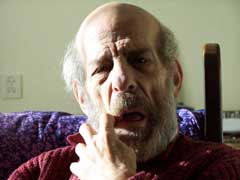Homoeopathic agriculture pioneers
Rudolf Steiner: biodynamics
Lilly and Eugen Kolisko
May E Bruce
Hugo Erbe
Glen Atkinson
Enzo Nastati
Konrad Wurthle
GSR Murthy
Vaikunthanath Das Kaviraj
Iftikhar Waris
Others ...
In the Autumn of 1986 Vaikunthanath Das Kaviraj was visiting a friend's
house in Switzerland. They had some problems with their fruit trees,
and since the family had fared well with homoeopathic treatments, the
mother argued, why not the fruit trees? Around the back,
pear and apple trees were growing along trellis. The leaves
had dark red rings erupting which had spread through the trees very
quickly. The trees were demanding of water. In a human these would
be close to the symptoms of the remedy Belladonna so that was given
to the trees. The trees
recovered, the fruit lost the bitter taste of previous years, and there
has been no sign of rust ever since.
Vaikunthanath Das Kaviraj has been trying remedies of the
homoeopathic pharmacopoeia, sometimes using this anthropomorphic projection
onto plants as a first guess, sometimes using the companion plants
in potency, occasionally using the pests as a nosode whilst at other
times the predator has been applied. The gleanings of this first tentative
step into a new field is now recorded in Vaikunthanath Das Kaviraj's
materia medica and the first
attempts at a structure of a repertory.
This was published in the book 'Homoeopathy
for Farm and Garden' in
2006, and Considera has been granted permission to take this seed and
grow it on the web!
Vaikunthanath Das Kaviraj, a
Dutch homoeopath, has based his approach and recommendations firmly
on the shoulders of Hahnemann and Kent and the classical school of
homoeopathy: the minimum dose, the similimum, the totality of the symptoms,
a single dose of a simple remedy. These pillars of Hahnemannian homoeopathy
remain in this agricultural homoeopathy.
An issue that was clarified for me when reading the materia medica is that
when one is using a pesticide one is focusing upon the pest; when
using a poison one is focusing upon the organism which is supposed
to be the 'cause' of the disease. But pests are ubiquitous as are pathogenic
organisms. A question is why some plants thrive in their presence and
others fall ill. The therapeutic approach depends on the answer to
this. If the opportunistic pathogen gets the plant because of the randomness
of nature - if it is just the plant's turn - then it is reasonable to deal
directly with the pathogen. However, if one answers that the health
of the plant is reflected in its susceptibility to those pathogens,
then one will focus on the plant and its health. Seen from the
second perspective the poisonous herbicides and pesticides are just
another burden to an ailing plant and, not only are they unhelpful to
the health of the plant, they add insult to injury.
The majority of the first homeopathic preparations that went in the materia medica have been suggested by Kaviraj in his "Homeopathy for Farm and Garden", and the one everyone in the UK asks about is Helix Tosta for slugs.
It is a great loss to our small commmunity that Kavi died in 2013. I wrote a small memory for hpathy.




